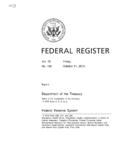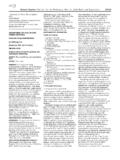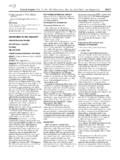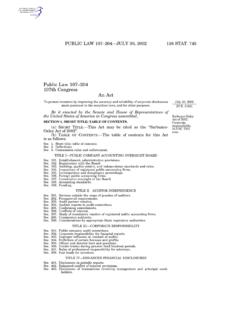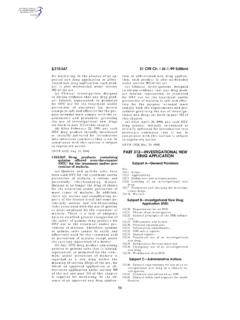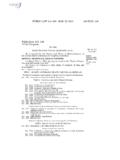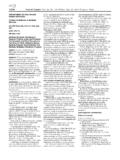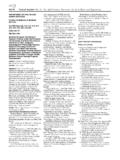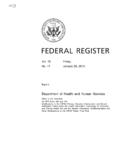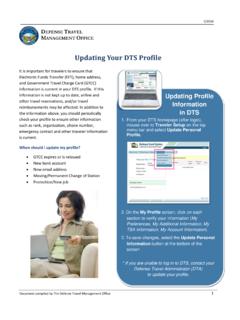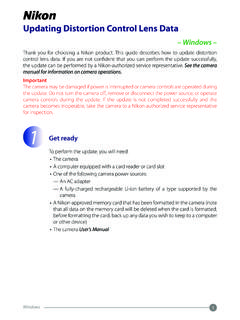Transcription of 34000 Federal Register /Vol. 81, No. 103/Friday, May 27 ...
1 34000 Federal Register / Vol. 81, No. 103 / Friday, May 27, 2016 / rules and regulations DEPARTMENT OF HEALTH AND HUMAN SERVICES Food and Drug Administration 21 CFR Part 101 [Docket No. FDA 2004 N 0258 (Formerly Docket No. 2004N 0456)] RIN 0910 AF23 Food Labeling: Serving Sizes of Foods That Can Reasonably Be Consumed At One Eating Occasion; Dual-Column Labeling; Updating, Modifying, and Establishing Certain Reference Amounts Customarily Consumed; Serving Size for Breath Mints; and Technical Amendments AGENCY: Food and Drug Administration, HHS. ACTION: Final rule. SUMMARY: The Food and Drug Administration (FDA or we) is issuing a final rule to define a single-serving container; require dual-column labeling for certain containers; update, modify, and establish several reference amounts customarily consumed (RACCs); amend the label serving size for breath mints; and make technical amendments to various aspects of the serving size regulations . We are taking this action to provide consumers with more accurate and up-to-date information on serving sizes.
2 DATES: Effective date: The final rule becomes effective on July 26, 2016 . Compliance date: The compliance date of this final rule is July 26, 2018, for manufacturers with $10 million or more in annual food sales, and July 26, 2019, for manufacturers with less than $10 million in annual food sales. See Section IV, Effective and Compliance Dates, for more detail. FOR FURTHER INFORMATION CONTACT: With regard to the final rule: Cherisa Henderson, Center for Food Safety and Applied Nutrition (HFS 830), Food and Drug Administration, 5100 Paint Branch Pkwy., College Park, MD 20740, 240 402 1450, With regard to the information collection: Domini Bean, Office of Information Management, Food and Drug Administration, 8455 Colesville Rd., Rm. 14537G, Silver Spring, MD 20903, SUPPLEMENTARY INFORMATION: Table of Contents I. Executive Summary A. Purpose of the Final Rule B. Summary of the Legal Authority C. Summary of the Major Provisions of the Final Rule D. Technical Amendments E.
3 Effective and Compliance Dates F. Costs and Benefits II. Background A. Serving Size Proposed Rule B. Legal Authority III. Comments and FDA s Responses A. General Comments B. Single-Serving Containers C. Dual-Column Labeling D. Reference Amounts Customarily Consumed E. Impact of Changes in RACCs on the Eligibility To Make Nutrient Content Claims and Health Claims F. Establishing a New Serving Size for Breath Mints G. Technical Amendments IV. Effective and Compliance Dates V. Analysis of Environmental Impact VI. Economic Analysis of Impacts VII. Paperwork Reduction Act of 1995 VIII. Federalism IX. References I. Executive Summary A. Purpose of the Final Rule Following the passage of the Nutrition Labeling and Education Act (NLEA) of 1990 (Pub. L. 101 535), which added section 403(q) of the Federal Food, Drug, and Cosmetic Act (the FD&C Act) (21 343(q)), we issued various regulations related to serving size requirements (see 21 CFR and ). Since we established those regulations , there have been developments that have compelled us to reevaluate our regulations on serving sizes and determine whether and what, if any, revisions are needed to ensure that the Nutrition Facts label meets its intended goal of providing consumers information to assist them in maintaining healthy dietary practices.
4 Specifically, such developments include the availability of newer consumption data, research showing that amounts of food consumed by the American public have changed, and the availability of recent consumer research on the use and understanding of the Nutrition Facts label. In consideration of these new developments, this rule amends our regulations in and Resulting from our evaluation of the new consumption data, this rule amends the RACCs that are used to determine serving sizes consistent with section 403(q)(1)(A)(i) of the FD&C Act, which states that a serving size is an amount of food customarily consumed. Additionally, in consideration of recent consumption data, research on consumption, and research on consumer understanding of the Nutrition Facts label, this rule amends some of the required procedures used to determine serving sizes, amends the definition of a single-serving container, and requires that certain containers of foods bear an additional column of nutrition information to help consumers understand the nutritional significance of consuming an entire container of certain foods containing multiple servings.
5 Overall, the changes finalized in this rule are designed to ensure that serving sizes are based on current consumption data and to provide consumers with information on the Nutrition Facts label related to the serving size that will assist them in maintaining healthy dietary practices. B. Summary of the Legal Authority The NLEA amended the FD&C Act to provide FDA with the authority to require nutrition labeling on most packaged foods we regulate. Specifically, section 403(q)(1)(A)(i) of the FD&C Act requires, with certain exceptions, that food that is intended for human consumption and offered for sale bear nutrition information that provides a serving size that reflects the amount of food customarily consumed and is expressed in a common household measure that is appropriate to the food, and is our primary legal authority to issue the regulations in this final rule. Section 2(b)(1)(B) of the NLEA further requires the Secretary of Health and Human Services to issue regulations which establish standards.
6 To define serving size. Additionally, we are relying on section 2(b)(1)(A) of the NLEA, which states that requirements in regulations issued under the authority of the NLEA, including serving size requirements, shall be conveyed to the public in a manner which enables the public to readily observe and comprehend such information and to understand its relative significance in the context of a total daily diet. Finally, we are relying on the authorities in sections 701(a), 403(a)(1), and 201(n) of the FD&C Act (21 371(a), 343(a)(1), and 321(n)) for amendments in this final rule. Under section 701(a) of the FD&C Act, we have authority to issue regulations for the efficient enforcement of the FD&C Act. Under section 403(a) of the FD&C Act, a food is deemed misbranded if its labeling is false or misleading in any particular. Additionally, under section 201(n) of the FD&C Act, in determining whether or not a food is misbranded because its labeling is misleading, we must take into account not only representations made or suggested, but also the extent to which the labeling fails to reveal facts that are material in light of such representations or material with respect to consequences that may result from the use of the food.
7 All of the authorities listed in this paragraph VerDate Sep<11>2014 18:17 May 26, 2016 Jkt 238001 PO 00000 Frm 00260 Fmt 4701 Sfmt 4700 E:\FR\FM\ 27 MYR2mstockstill on DSK3G9T082 PROD with RULES234001 Federal Register / Vol. 81, No. 103 / Friday, May 27, 2016 / rules and regulations 1 There is substantial uncertainty regarding the impacts of the two nutrition labeling rules . For a full discussion of the uncertainty, please see the Welfare Estimates Primary Sensitivity Analysis section of the Regulatory Impact Analysis. give us the authority to issue this final rule related to serving size labeling. C. Summary of the Major Provisions of the Final Rule 1. Single-Serving Containers and Dual- Column Labeling Over the last 20 years, evidence has accumulated demonstrating that container and unit sizes can influence the amount of food consumed. For containers and units of certain sizes, consumers are likely to eat the entire container or unit in one sitting.
8 For other container and unit sizes, consumers may consume the container or unit in one sitting or may consume the container or unit over multiple sittings or share the container or unit contents with other consumers. To address containers that may be consumed in a single-eating occasion, we are requiring that all containers, including containers of products with large RACCs ( , products with RACCs of at least 100 grams (g) or 100 milliliters (mL)), containing less than 200 percent of the RACC be labeled as a single-serving container. To address containers and units that may be consumed in one or more sittings, or shared, we are requiring that containers and units that contain at least 200 percent and up to and including 300 percent of the RACC be labeled with a column of nutrition information within the Nutrition Facts label that lists the quantitative amounts and percent DVs for the entire container, in addition to the required column listing the quantitative amounts and percent DVs for a serving that is less than the entire container ( , the serving size derived from the RACC).
9 2. Changing the RACCs We established RACCs in 1993 based, in part, on data from Nationwide Food Consumption Surveys (1977 1978 and 1987 1988) conducted by the Department of Agriculture (USDA). Over the last decade, there has been general recognition that consumption patterns have changed. To determine changes in serving sizes and whether the RACCs should be updated, we analyzed recent food consumption data from the 2003 2008 National Health and Nutrition Examination Surveys (NHANES) (hereinafter referred to as the NHANES 2003 2008 surveys or NHANES 2003 2008 consumption data, as applicable). Generally, this rule amends RACCs if the NHANES median consumption data have increased or decreased by at least 25 percent compared to the 1993 RACCs. However, consistent with our regulations in (a), we have considered other factors, such as designating the same RACCs for products with similar consumption data and similar dietary usage or product characteristics. In addition, since the final rule on serving sizes published in 1993, we have received requests from manufacturers to modify, establish, and identify appropriate product categories within the tables in (b) and change the serving size for various food products.
10 Using the data currently available to us, we are also addressing these requests in this final rule. D. Technical Amendments We have been alerted to a number of technical amendments that should be made to the serving size regulations in and This final rule includes a number of technical amendments to help clarify the serving size requirements in these regulations . E. Effective and Compliance Dates We are establishing a compliance date of 2 years after the final rule s effective date for manufacturers with $10 million or more in annual food sales, and 3 years after the final rule s effective date for manufacturers with less than $10 million in annual food sales. (For more details, see Section IV, Effective and Compliance Dates.) F. Costs and Benefits We have developed one final regulatory impact analysis (FRIA) for this final rule as well as the final rule entitled Food Labeling: Revision of the Nutrition and Supplement Facts Labels (the Nutrition Facts final rule).

